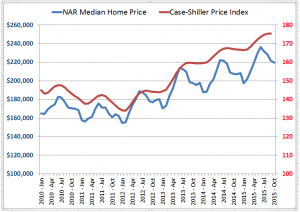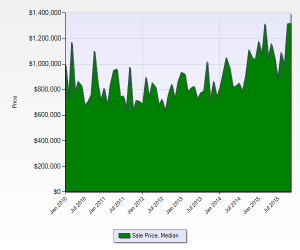Now is the Best Season to Buy a Home
There is a discount to be had for the few buyers purchasing over the holidays. (Written by Lawrence Yun and published 12/2/15 on Forbes.com. See note below for Park City insights)
With increasing incidences of unruly shoppers competing over holiday sales, it could well be the best time of the year to be among the exceptionally few buying a big ticket item that both adds value and is long lasting. The big ticket item in this case is a home. About one million consumers will purchase a home from November to January this year, when home prices are a bit softer.
As you may know, the typical home price tends to rise around 3% to 5% per year. This year in 2015, the gain is a bit stronger at 6% because of the ongoing shortage of inventory in many markets. But the annual price gain does not smoothly and steadily change from one month to the next. There is a clear seasonal pattern of rising prices from the spring home buying season to the end of summer. Then prices mildly retreat. Closings in January provide the best discount for home buyers, meaning that buyers get the best deal when they get the home under contract around December.
The graph below shows the median home price over the past five years. Note the month-to-month price swings that occur nearly every year with home prices retreating over the winter months. The seasonal decline is not all price depreciation of homes. A good portion of movement is driven by a higher proportion of lower priced and smaller-sized homes getting sold during the winter months. The reason for this is families with school-aged kids are generally not in the market during the winter because they do not want their kids to be disrupted during a school year, and it is the families with kids that generally require the larger homes that carry higher prices. So not all of the decline in home prices in winter is a genuine price depreciation, but is driven partly or largely by the different mix of homes being sold this time of year.
There is another home price measurement that can better delineate true price change from the changes in the mix of homes that are sold. The Case-Shiller price index, of which pair the latter professor won the Nobel Prize in economics, uses something called a repeat-sales price measurement. Briefly, they look at how a given property has changed in value from the first purchase to the second purchase. An algorithm is then applied over all properties sold to reveal a price index over time. Though there are caveats and statistical noise, the Case –Shiller index does a good job of capturing a genuine price change uninfluenced by the type or mix of homes sold at certain time of the year.
Yet even in this price index, one notices mild swings in the data with prices falling over the winter months. Real estate professionals know this to be true in everyday business since there are far fewer buyers shopping over the holidays; as a result, listed homes staying on the market for a longer period. In short, there is a discount to be had for the few buyers purchasing over the holidays.
Note from Nancy Tallman—I checked the statistics for Park City 84098 and 84060 and this trend holds true in Park City. See the graph below. If you are looking to move up, buy a second home or investment property in Park City, now is the time to act. Contact me at 435.901.0659.

